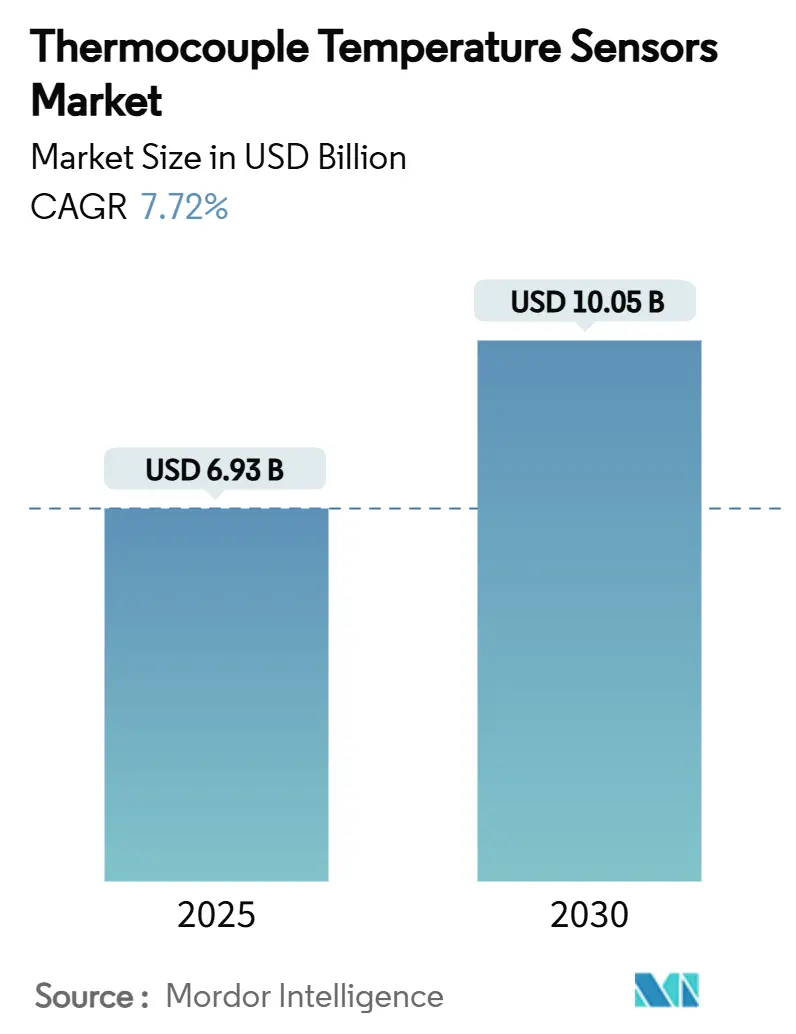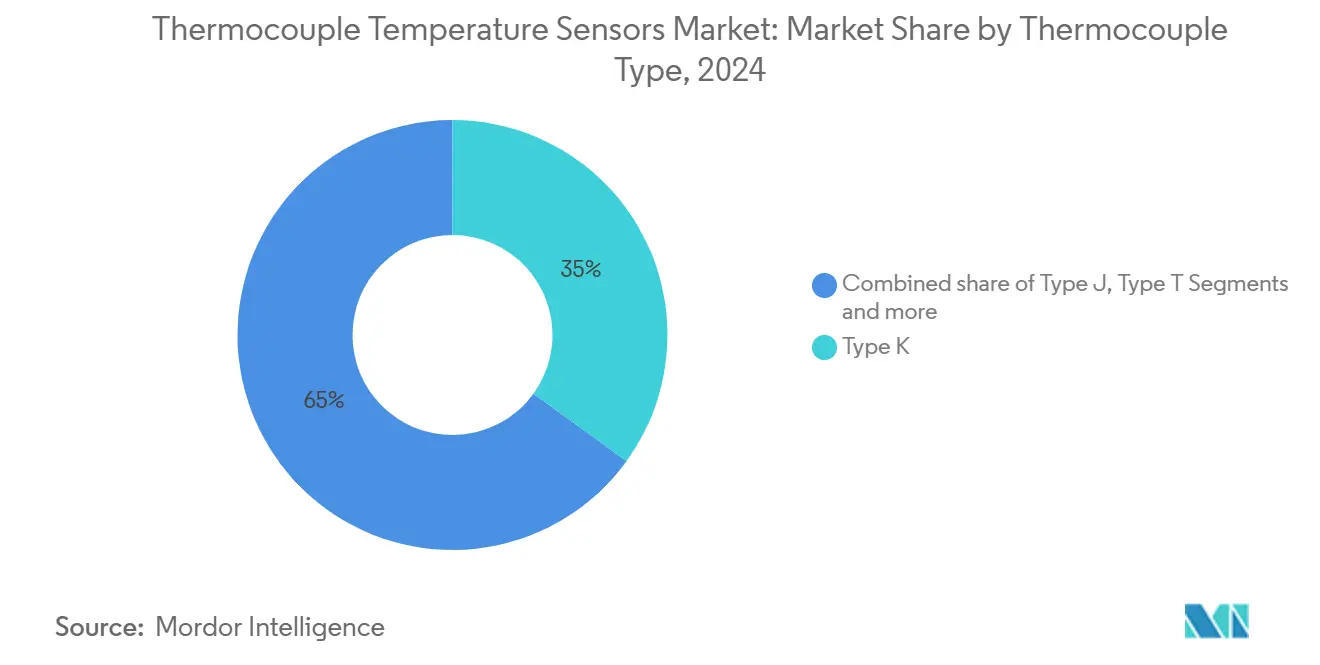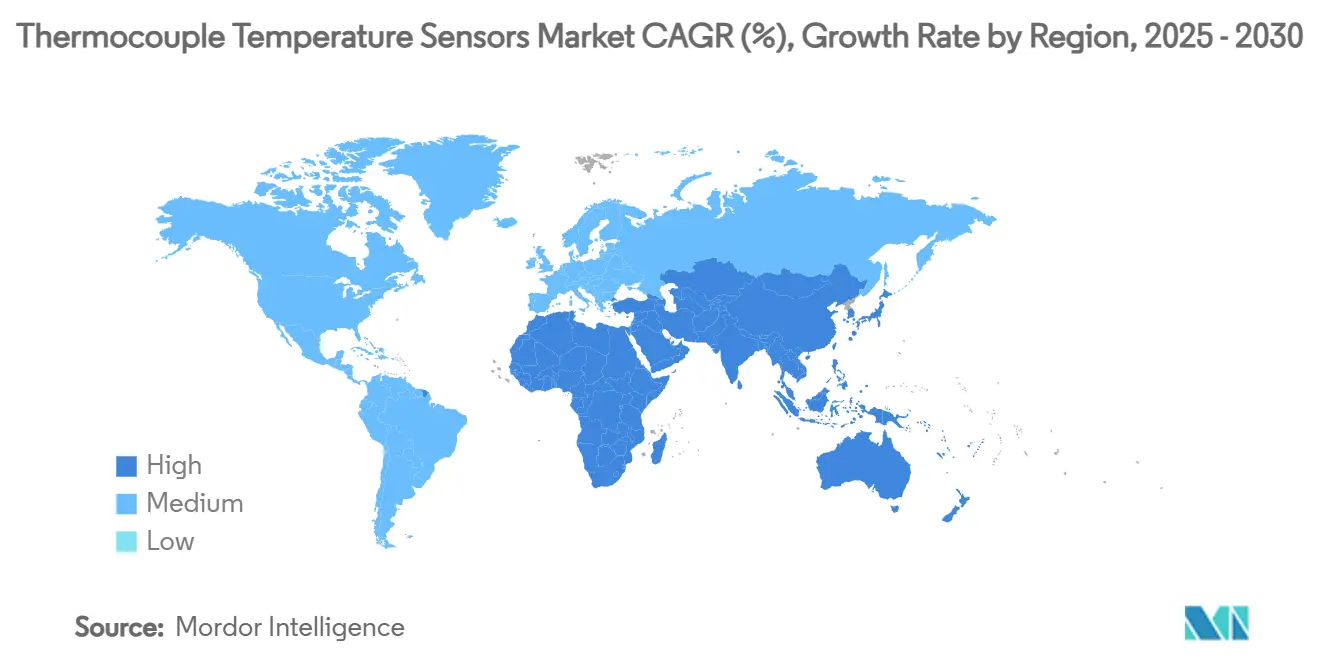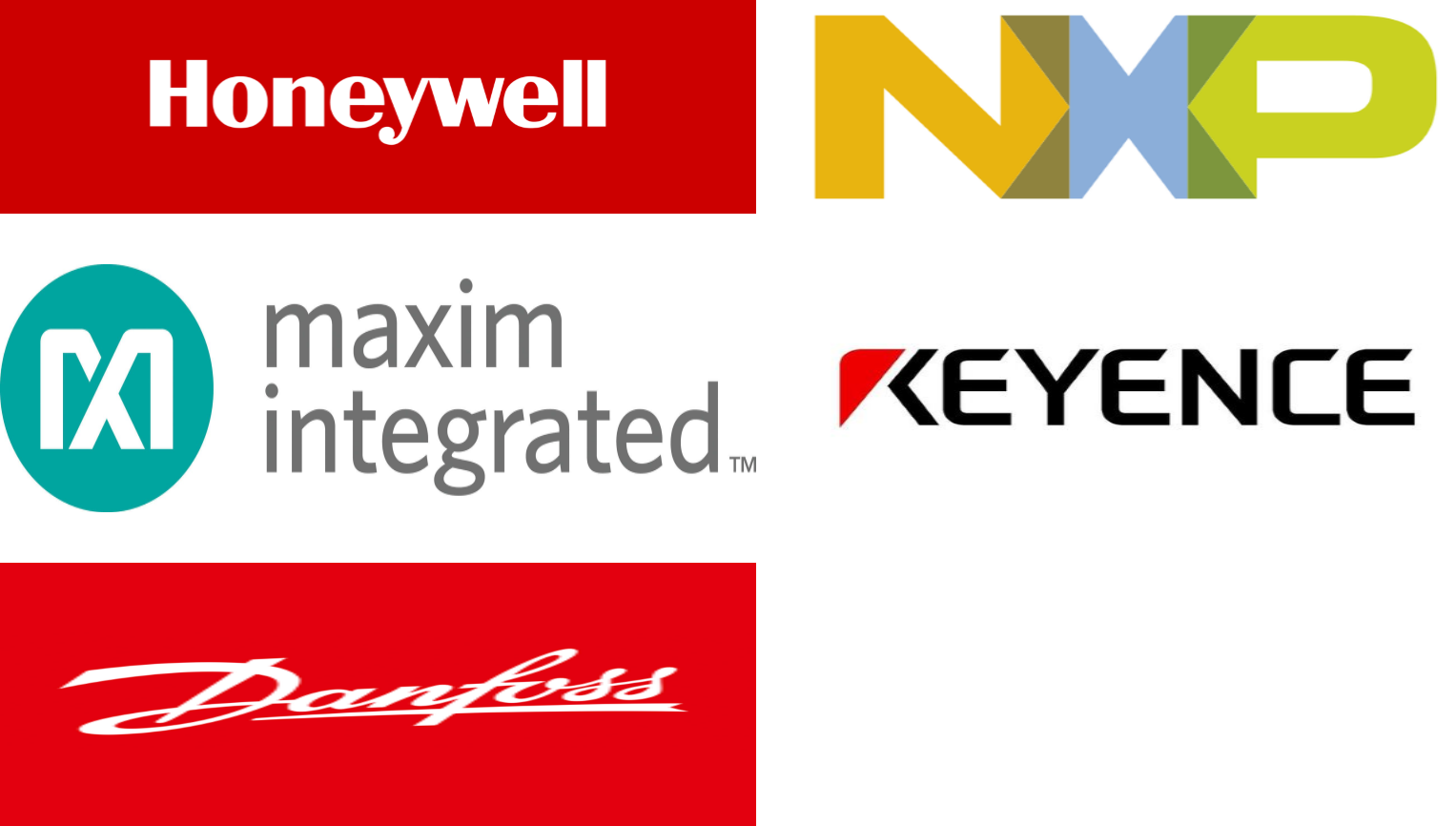Thermocouple Temperature Sensors Market Size and Share

Thermocouple Temperature Sensors Market Analysis by Mordor Intelligence
The thermocouple temperature sensors market size is valued at USD 6.93 billion in 2025 and is forecast to reach USD 10.05 billion by 2030, reflecting a 7.72% CAGR. Demand stems from industries where real-time thermal data underpins efficiency, safety and yield—especially at temperatures where RTDs and thermistors fall short. Expansion in Industry 4.0 retrofits, green-hydrogen electrolysers, LNG infrastructure and EV battery gigafactories is elevating use cases that favour Type K, N and T probes. At the same time, digital networking standards such as EtherNet/IP profiles are turning legacy sensors into smart nodes that feed predictive-maintenance platforms. Intensifying competition comes from low-cost Asian imports and fiber-optic alternatives, yet regulatory mandates for tighter motor-efficiency tests and embedded monitoring add fresh tailwinds. [1]ODVA, “EtherNet/IP Expands with New Process Device Profiles for RTD & Thermocouple Temperature Sensors,” arcweb.com
Key Report Takeaways
- By thermocouple type: Type K held 35% of the thermocouple temperature sensors market share in 2024, while Type N is projected to grow at an 8.9% CAGR through 2030.
- By end-user industry: Chemicals & petrochemicals accounted for 25% share of the thermocouple temperature sensors market size in 2024; automotive & EV batteries are advancing at a 12% CAGR to 2030.
- By region: Asia Pacific led with 42% revenue share in 2024; the Middle East is set to expand at a 9.5% CAGR between 2025-2030.
- By temperature range: The 350 °C–700 °C segment captured 40% of the thermocouple temperature sensors market size in 2024, whereas applications above 700 °C are forecast to rise at 8.1% CAGR.
Global Thermocouple Temperature Sensors Market Trends and Insights
Drivers Impact Analysis
| Driver | ( ~ ) % Impact on CAGR Forecast | Geographic Relevance | Impact Timeline |
|---|---|---|---|
| Shift toward predictive maintenance in Industry 4.0 boosting multi-point thermocouple retrofits across European factories | +1.2% | Europe, North America | Medium term (2-4 years) |
| Expansion of green-hydrogen electrolyzer build-outs (>800 °C monitoring) in Asia Pacific | +0.8% | Asia Pacific, Europe | Long term (≥ 4 years) |
| LNG regasification terminal build-outs requiring cryogenic Type-T probes in North America | +0.7% | North America, Asia Pacific | Medium term (2-4 years) |
| EV battery gigafactory kiln installations in China demanding high-accuracy Type-K sensors | +1.5% | Asia Pacific, North America, Europe | Short term (≤ 2 years) |
| EU Regulation 2019/1781 mandating tighter motor-efficiency tests and embedded thermocouples | +0.9% | Europe, Global | Medium term (2-4 years) |
| Source: Mordor Intelligence | |||
Predictive maintenance driving multi-point thermocouple adoption
Factory operators adopting Industry 4.0 standards are replacing single-point sensors with multi-point thermocouple strings that create detailed thermal maps. When paired with machine-learning algorithms, these arrays detect drift or hotspots weeks ahead of a fault, reducing unplanned downtime by up to 30%. European plants pioneered the retrofit wave, yet North American automakers and chemical processors are following as CEN Workshop Agreement 18038 offers a blueprint for data-driven maintenance. Broader adoption is fuelled by falling computing costs and ODVA’s plug-and-play EtherNet/IP profiles that shrink integration time. As more plants normalize thermal profiling, suppliers able to bundle sensors with analytics services capture higher margins. [2]CEN-CENELEC, “CEN Workshop Agreement 18038,” cencenelec.eu
Green hydrogen driving high-temperature monitoring demand
Scaling of solid-oxide electrolyser cells pushes operating zones beyond 800 °C, a threshold where Type N and upgraded Type K probes outclass other metal-based sensors. Continuous profiling guards against thermal cycling that shortens stack life, and California Energy Commission grants have sharpened global attention on temperature-control protocols. Asian electrolyser vendors now specify pre-welded mineral-insulated (MI) assemblies rated for hydrogen exposure, creating a premium tier within the thermocouple temperature sensors market. As European climate-policy funds funnel into green-hydrogen clusters, collective demand for ultra-stable probes widens the addressable sales pool well past pilot plants. [3]California Energy Commission, “Advanced Lithium-Ion Chemistry for Safer and Greener Electric Vehicle and Energy Storage Systems,” energy.ca.gov
LNG infrastructure expansion boosts cryogenic sensor demand
North America is ramping LNG export capacity, and each liquefaction or regasification train can house hundreds of Type T points that measure as low as –200 °C. Precise cryogenic control curbs boil-off gas losses and prevents brittle-fracture hazards, leading to robust specification of copper-constantan probes despite price competition in other segments. Because LNG contracts reward energy efficiency, operators accept a premium for Class-A accuracy probes with third-party certifications. The same design expertise travels to Asia-Pacific import terminals, giving established suppliers avenues to sidestep commoditized markets while leveraging volume manufacturing.
EV battery manufacturing driving precision temperature control
In gigafactories, kiln temperatures during electrode coating and solvent drying dictate porosity and adhesion. Research documents that ±5 °C swings can erode cell capacity and safety limits. High-accuracy Type K assemblies, often with ungrounded junctions to avoid ground-loop interference, are embedded across conveyors and formation lines. China’s rapid capacity additions absorb the bulk of demand, yet European projects scheduled for 2025-2027 are adopting similar sensor counts per gigawatt-hour. IoT gateways now aggregate these probes, enabling closed-loop heater control that lifts first-pass yield. The trend pushes suppliers to integrate self-diagnostics and digital calibration chips, differentiating premium offerings.
Restraints Impact Analysis
| Restraint | ( ~ ) % Impact on CAGR Forecast | Geographic Relevance | Impact Timeline |
|---|---|---|---|
| Price erosion from commoditized K & J imports out of low-cost Asian supply chains | -0.9% | Global, most acute in North America and Europe | Short term (≤ 2 years) |
| Substitution threat from fiber-optic sensors in high-EMI aerospace engines | -0.6% | North America, Europe | Medium term (2-4 years) |
| Calibration drift >1 200 °C limiting use in semiconductor epitaxy lines | -0.5% | Asia Pacific, North America | Medium term (2-4 years) |
| Nickel & chromium supply volatility disrupting MI-cable probe output in Europe | -0.7% | Europe | Short term (≤ 2 years) |
| Source: Mordor Intelligence | |||
Price erosion challenging Western manufacturers
A surge of low-cost K and J probes from China and India has cut average selling prices by 15-20% since 2023, squeezing margins on standard assemblies that make up over half of unit volumes. Asian vendors also ship MI cables at 30-40% discounts, forcing legacy brands to pivot toward specialized designs or service-heavy contracts. Distributors in the United States report inventory turns slowing as end users defer replacements in anticipation of further price drops. Short-cycle inflationary spikes in nickel and chromium amplify cost control woes for European firms, yet buyers remain reluctant to shoulder surcharges, deepening the restraint on revenue growth.
Fiber-optic sensors threatening high-EMI applications
Fluorescence-based fiber-optic systems deliver ±0.1 °C accuracy across 200 °C–1600 °C while remaining immune to EMI, a critical trait inside turbine nacelles and generator stators. Aerospace primes increasingly evaluate optical suites that dispense with shielding and reduce wiring weight. Thermocouple vendors counter with dual-redundant junctions and EMI-hardened transmitters, but mission-critical contracts may still swing toward optics over the medium term. Loss of these high-margin niches tempers the otherwise healthy outlook of the thermocouple temperature sensors market.
Segment Analysis
By Thermocouple Type: Type N consolidates stability advantages
Type K maintained a 35% hold on the thermocouple temperature sensors market share in 2024 on versatility across –200 °C to +1350 °C. That span covers mainstream manufacturing, food processing and HVAC loops, positioning the variant for volume contracts even as commoditization trims margins. Type N, however, is capturing orders in aerospace test stands and hydrogen reactors at an 8.9% CAGR through 2030, aided by immunity to green-rot oxidation. OEMs see life-cycle savings from longer calibration intervals, swinging purchasing departments toward higher upfront costs. Emerging R, S and B alloys remain priced for boutique ultra-high-temperature work, but incremental breakthroughs in platinum wire purity are nudging them into semiconductor epitaxy lines where 1200 °C drift control is paramount.
Recent material science gains widen adoption envelopes. Thin-film deposition now embeds micron-scale thermocouple grids on ceramic substrates, serving real-time wafer temperature measurement. Suppliers highlight alumina insulation and Fibro Platinum wire for 1600 °C continuous service, enabling glass, refractory and additive-manufacturing kilns to retire legacy optical pyrometers. Type T retains a thriving micro-niche at –200 °C LNG duties where accuracy trumps cost. Collectively, these moves reinforce the premium segments’ resilience against bulk price compression.

Note: Segment shares of all individual segments available upon report purchase
By Junction Type: Ungrounded designs balance response and isolation
Grounded junction models still dominate OEM catalogues because they achieve millisecond response times. Yet the push for electrical isolation in servo drives and variable-frequency motor systems moves procurement toward ungrounded versions that damp ground-loop noise by 90% while sacrificing only 20% response speed. Semiconductor fabricators specify these variants to shield sensitive measurement electronics from stray currents. Exposed junctions continue in lab glassware and non-pressurized pilot rigs but carry limited share due to fragility. As factories re-wire for predictive maintenance, control engineers balance electromagnetic compatibility against dynamic response, favouring hybrid designs such as partially insulated mini junctions.
Advances in laser-welded tip construction lift fatigue life, letting ungrounded MI probes survive high-vibration turbine stages. Vendors add miniature connectors and epoxy potting salts that improve seal integrity without hampering thermal lag. Some battery producers adopt clip-on skin sensors—essentially exposed junctions set in ceramic beads—to audit cell casing temperatures, pulling junction innovation into consumer-electronics territory. These cross-industry learnings keep the thermocouple temperature sensors market vibrant despite encroachment from silicon-based chips.
By Temperature Range: High-temperature niches command premium positioning
The 350 °C–700 °C band represents the highest revenue slice, tied to continuous processes in petrochemical crackers, power boilers and rotary kilns. Customers prize stable mean time between calibrations, often extending probe life beyond 5 years via periodic in-situ checks. Segments above 700 °C—smaller in shipments yet lucrative—grow at 8.1% CAGR, driven by semiconductor oxidation furnaces, specialty-alloy casting and green-hydrogen SOEC stacks. At the cold extreme, Type T probes shoulder cryogenic tasks, ensuring product integrity during LNG loading where –162 °C surface oscillations tweak boil-off rates.
Competitively, NATO research cites optical sensors now tolerating 1800 °C, yet qualified Type S couples still rule at 1600 °C because of easier installation and field interchangeability. Cryogenic innovations include ultra-thin fluoropolymer jackets that slash thermal mass, letting LNG operators detect one-degree shifts within seconds. Accordingly, manufacturers leverage temperature-range specialization to buffer against price wars, anchoring brand loyalty in mission-critical process windows. [4]NATO Science and Technology Organization, “Overview of Modern Instrumentation Technology,” sto.nato.int
By Probe Configuration: Mineral-insulated designs dominate industrial applications
Mineral-insulated cable assemblies own the lion’s share of industrial spend, valued for hermetic sealing, vibration endurance and continuous service to 1250 °C. OEMs in refineries and cement plants issue blanket orders for MI probes paired with Inconel thermowells, easing spares logistics and maintenance schedules. Thermowell-protected cartridges retain relevance where operators need probe swaps without cracking pressurized lines, while beaded-wire versions stay confined to bench testing or rapid-burn combustion R&D.
Designers now splice multi-point hot zones within a single sheath, giving engineers a gradient map instead of discrete data points. Suppliers such as TC Direct showcase miniature MI cables under 1 mm diameter, melding rapid response with industrial toughness. In parallel, sheath alloys evolve; Inconel 625 layers fight sulfidation in sour-gas streams, while Hastelloy C-276 covers acid leach circuits. The evolution underscores how mechanical packaging safeguards the high-precision core, sustaining MI designs as the dominant backbone of the thermocouple temperature sensors market.
By End-User Industry: Chemicals & petrochemicals lead while automotive accelerates
At 25% share, chemicals and petrochemicals rely on dense arrays of thermocouples in distillation, cracking and polymerization where runaway heat jeopardizes safety and yield. Hazardous-area certifications (ATEX, CSA) ensure probes integrate seamlessly with distributed control systems. Plant revamps often mandate simultaneous sensor upgrades, extending replacement cycles yet boosting order value through bundled diagnostics.
The automotive and EV battery sector grows fastest at 12% CAGR. Each gigafactory line may embed thousands of Type K inputs across drying ovens, formation chambers and thermal runaway barriers. With Europe racing to shore up battery sovereignty, regional makers commission smart probes tagged with EEPROM chips storing calibration data, simplifying line cloning and maintenance. Oil & gas, semiconductors, food & beverage and HVAC maintain steady volumes, yet digital transformation shifts revenue mix toward subscription services—remote calibration portals, cloud dashboards and analytics—that monetize sensor data beyond hardware.

Note: Segment shares of all individual segments available upon report purchase
Geography Analysis
Asia Pacific’s 42% command of the thermocouple temperature sensors market rests on its dense manufacturing base. China’s battery kilns and Japan’s chip fabs consume high-accuracy probes, while South Korea specifies platinum alloys for OLED glass melt zones. India’s petrochemical expansion adds orders for standard K and J variants yet increasingly demands local content, spurring joint ventures. Low-cost plants across the region manufacture commoditized probes that flow into global supply chains, creating price headwinds elsewhere.
The Middle East posts the quickest regional climb at 9.5% CAGR through 2030. Saudi Aramco-approved facilities in Dammam now produce MI probes and thermowells domestically. Investment flows span petrochemical hubs, solar-thermal farms and desalination units, all requiring rugged sensors from cryogenic to 1000 °C zones. Local assembly shortens lead times and helps suppliers meet in-country value mandates, reshaping distribution networks in the thermocouple temperature sensors market.
North America maintains substantial share via aerospace, LNG and advanced manufacturing. New liquefaction trains along the Gulf Coast order Type T strings for –162 °C service, whereas jet-engine OEMs qualify noble-metal probes for 1200 °C combustors. Europe’s uptake hinges on regulatory stimuli; EU Motor Regulation 2019/1781 obliges embedded thermocouple verification for efficiency labelling, and hydrogen pilot plants in Germany necessitate 900 °C measurement of SOEC stacks. South America and Africa remain nascent but show upticks tied to mining, pulp-and-paper and fertilizer plants seeking process upgrades.

Competitive Landscape
Competition is moderately fragmented. Global brands—Omega Engineering (Spectris), Emerson, Endress+Hauser, ABB, Yokogawa, WIKA—blend sprawling portfolios with calibration labs and digital gateways. Mid-tier specialists such as Tempsens or Pyromation emphasize rapid customization, while Asian mass producers leverage scale for cost leadership. Consolidation among distributors continues; Thermal Technology Distribution Solutions completed five acquisitions since 2023, widening its U.S. footprint.
Technology differentiation pivots on materials and connectivity. Kamet Trading patented Type C and D assemblies for 2300 °C aerospace furnaces. ODVA’s EtherNet/IP profiles accelerate sensor-to-PLC interoperability, rewarding firms that embed digital descriptors into transmitters. While commoditized K and J probes see razor-thin margins, niche plays in high-temperature, cryogenic or EMI-heavy environments yield robust profitability. Fiber-optic challengers force thermocouple suppliers to package added value—auto-calibration, self-diagnostics, on-site swap programs—to defend strategic accounts in the thermocouple temperature sensors market.
Thermocouple Temperature Sensors Industry Leaders
-
Omega Engineering (Spectris plc)
-
Emerson Electric Co.
-
Endress+Hauser Group
-
Honeywell International Inc.
-
ABB Ltd
- *Disclaimer: Major Players sorted in no particular order

Recent Industry Developments
- April 2025: Omega Engineering broadened its fiber-optic line to rival thermocouples in EMI-rich aerospace turbines, specifying 200 °C–1600 °C coverage.
- March 2025: Pelican Wire released enhanced K-type wire aimed at manufacturing and food-processing segments, touting tight tolerance and life-cycle traceability.
- December 2024: TTDS acquired Applied Thermal Systems, marking its fifth buy-out in 14 months and expanding Mid-west distribution of thermocouple assemblies.
- June 2024: TTDS bought Thermal Devices to strengthen Mid-Atlantic sales channels for heaters, controls and temperature sensors.
Global Thermocouple Temperature Sensors Market Report Scope
| Type J |
| Type T |
| Type N |
| Type E |
| Type R and S |
| Type B |
| Others |
| Grounded Junction |
| Ungrounded Junction |
| Exposed Junction |
| Below 0 C |
| 0 C 350 C |
| 350 C 700 C |
| Above 700 C |
| Beaded-Wire |
| Mineral-Insulated (MI) Cable |
| Thermowell and Protection Tube |
| Surface and Penetration |
| Flexible / Custom Harness |
| Oil and Gas |
| Power Generation |
| Chemicals and Petrochemicals |
| Metals and Mining |
| Food and Beverage |
| Automotive and EV Battery |
| Aerospace and Defense |
| Semiconductor and Electronics |
| Healthcare and Life Sciences |
| HVAC and Building Automation |
| North America | United States |
| Canada | |
| Mexico | |
| Rest of North America | |
| South America | Brazil |
| Argentina | |
| Rest of South America | |
| Europe | Germany |
| United Kingdom | |
| France | |
| Italy | |
| Spain | |
| Russia | |
| Rest of Europe | |
| Asia Pacific | China |
| Japan | |
| India | |
| South Korea | |
| Australia | |
| Rest of Asia Pacific | |
| Middle East | Saudi Arabia |
| United Arab Emirates | |
| Turkey | |
| Rest of Middle East | |
| Africa | South Africa |
| Egypt | |
| Nigeria | |
| Rest of Africa |
| Thermocouple Type | Type J | |
| Type T | ||
| Type N | ||
| Type E | ||
| Type R and S | ||
| Type B | ||
| Others | ||
| By Junction Type | Grounded Junction | |
| Ungrounded Junction | ||
| Exposed Junction | ||
| By Temperature Range | Below 0 C | |
| 0 C 350 C | ||
| 350 C 700 C | ||
| Above 700 C | ||
| By Probe Configuration | Beaded-Wire | |
| Mineral-Insulated (MI) Cable | ||
| Thermowell and Protection Tube | ||
| Surface and Penetration | ||
| Flexible / Custom Harness | ||
| By End-User Industry | Oil and Gas | |
| Power Generation | ||
| Chemicals and Petrochemicals | ||
| Metals and Mining | ||
| Food and Beverage | ||
| Automotive and EV Battery | ||
| Aerospace and Defense | ||
| Semiconductor and Electronics | ||
| Healthcare and Life Sciences | ||
| HVAC and Building Automation | ||
| By Geography | North America | United States |
| Canada | ||
| Mexico | ||
| Rest of North America | ||
| South America | Brazil | |
| Argentina | ||
| Rest of South America | ||
| Europe | Germany | |
| United Kingdom | ||
| France | ||
| Italy | ||
| Spain | ||
| Russia | ||
| Rest of Europe | ||
| Asia Pacific | China | |
| Japan | ||
| India | ||
| South Korea | ||
| Australia | ||
| Rest of Asia Pacific | ||
| Middle East | Saudi Arabia | |
| United Arab Emirates | ||
| Turkey | ||
| Rest of Middle East | ||
| Africa | South Africa | |
| Egypt | ||
| Nigeria | ||
| Rest of Africa | ||
Key Questions Answered in the Report
What is the current value of the thermocouple temperature sensors market?
The market is worth USD 6.93 billion in 2025 and is projected to reach USD 10.05 billion by 2030 at a 7.72% CAGR.
Which thermocouple type dominates sales today?
Type K leads with 35% market share thanks to its wide temperature span and cost advantage.
Which region is growing fastest?
The Middle East shows the highest growth, with a 9.5% CAGR forecast for 2025-2030, driven by petrochemical and renewable-energy investments.
How are Industry 4.0 trends affecting sensor demand?
Predictive-maintenance programs are driving multi-point retrofits that transform thermocouples from simple probes into networked data sources.
Why are fiber-optic sensors considering a threat?
Fiber optics offer EMI immunity and ±0.1 °C accuracy in aerospace turbines, challenging thermocouples in high-value, high-interference zones.
Which end-user segment is expanding fastest?
Automotive and EV battery manufacturing is advancing at a 12% CAGR as gigafactories require precise kiln and formation temperature control.
Page last updated on:



